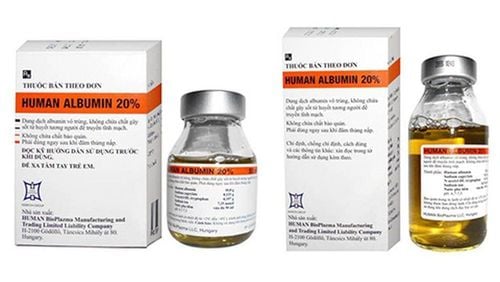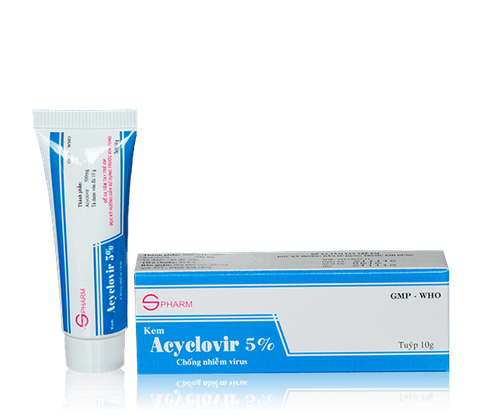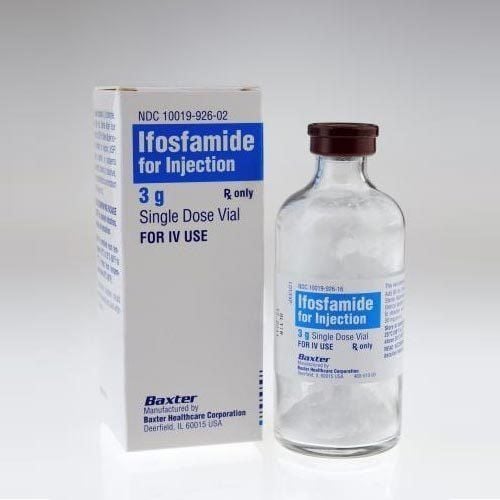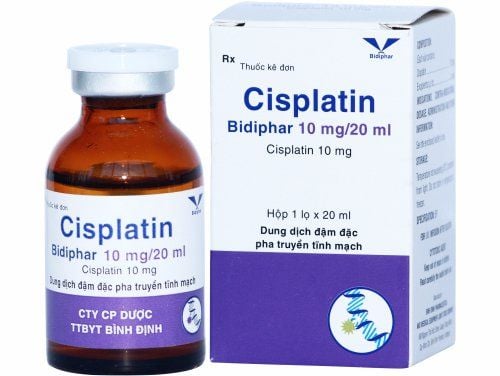This is an automatically translated article.
Preventing cancer cells from growing is one of the main mechanisms of action of therapeutic drugs. One of them is the drug Cisplatin and has been used in many different malignancies. So what is Cisplatin?
1. What is cisplatin?
Cisplatin is a heavy metal compound that inhibits RNA, DNA and protein synthesis in cells. These substances are all very important for cells to divide and grow, because the drug Cisplatin prevents them from dividing, so it can prevent cancer from growing.
Cisplatin drug is prepared in the form of intravenous solution with the concentrations of 200mg/200ml, 100mg/100ml and 50mg/50ml.
2. How to take Cisplatin
Cisplatin for intravenous use. The dose and schedule of treatment with Cisplatin depends on the patient's weight and specific cancer. Note that the patient should be given adequate fluids before infusion of Cisplatin.
Even when used carefully and correctly by healthcare professionals, Cisplatin can cause burns and pain at the site of infusion. At the same time, there is a risk that Cisplatin could leak out of the vein and lead to serious tissue damage. Therefore, if the injection site is red, swollen or painful during or after use, the patient should notify the medical staff immediately and absolutely do not search for solutions on the internet except when ordered by your doctor.
Cisplatin may affect the blood levels of some anticonvulsants. Therefore, patients must make sure to inform their treating physician about all medications and supplements they are taking.
3. Dosage of Cisplatin
Recommended dose of Cisplatin drug for adults with testicular cancer: Intravenous once daily at a dose of 20mg/m2 skin/day for 5 days for each cycle (need in combination with other therapeutic agents). other cancers);
Cisplatin dose for adults with ovarian cancer:
Intravenous dose 75-100mg/m2 skin every 4 weeks and must be combined with Cyclophosphamide to treat metastatic ovarian cancer; Alternative dose: Cisplatin intravenous infusion at a dose of 100 mg/m2 every 4 weeks (monotherapy for metastatic ovarian cancer); If ovarian cancer has metastasized to the peritoneal cavity, the patient can use a regimen of 60-90 mg/m2 intraperitoneal injection in 2000 ml of 0.9% sodium chloride or Ringer lactate solution. Alternative dose: 90-270 mg/m2 intraperitoneal injection in 2000 ml of 0.9% sodium chloride solution or Ringer Lactate. The recommended dose of Cisplatin for adults with bladder cancer:
Intravenous dose of 50-70 mg/m2/time every 3 to 4 weeks (monotherapy for advanced bladder cancer in patients with no history of bladder cancer) extensive radiation therapy or chemotherapy); Alternative dose: Cisplatin intravenous infusion at a dose of 50 mg/m2 over 6 to 8 hours every 4 weeks. The recommended dose of Cisplatin in adults with neuroblastoma: 60-100 mg/m2 of skin once every 3 to 4 weeks by IV infusion.
The usual dose of Cisplatin for adults with osteosarcoma: 60-100 mg/m2 of skin/time every 3-4 weeks.
Cisplatin dose for adults with brain/cranial tumors: 60 mg/m2 of skin/day, once for two consecutive days every 3-4 weeks.
Cisplatin dose for adults with bone marrow transplant: 55 mg/m2 skin/day for 3 days (Total dose is 165 mg/m2 skin).
Cisplatin dose for blood cell transplant recipients: 55 mg/m2 skin/day for 3 days (Total dose 165 mg/m2).
Cisplatin dose for patients with non-small cell lung cancer: 60-100 mg/m2 of skin/day every 21 days (in combination with other anti-cancer drugs).
4. Cisplatin side effects
4.1. Kidney damage Cisplatin can cause kidney problems, including increased blood creatinine levels. Your treating doctor will monitor this side effect with appropriate blood tests. Patients should note and notify their doctor if they have symptoms such as decreased urine output, blood in the urine, swelling of the ankles or loss of appetite.
4.2. Peripheral Neuropathy Cisplatin-induced peripheral neuropathy occurs as a result of toxicity affecting the nerves. Symptoms of this side effect include numbness or tingling in the hands and/or feet, which usually occurs when the patient is wearing socks or gloves. This condition may get worse as patients continue to use Cisplatin. In most cases the symptoms will slowly disappear when Cisplatin is stopped, but in some patients it never goes away completely. Patients should let their doctor know if they experience numbness or tingling in their hands and/or feet, as the dose of Cisplatin may need to be adjusted.
4.3. Decrease in the number of blood cells During treatment with Cisplatin, patients may experience a side effect of reducing 3 blood cell lines, including white blood cells, red blood cells and platelets. This leads to risks such as increased risk of infection, anemia, and abnormal bleeding.
Patients taking Cisplatin should inform their doctor when they have the following problems:
Signs of infection such as fever, sore throat, cold, difficulty breathing, cough, burning urine or slow-healing sores; Signs of anemia such as fatigue, weakness, shortness of breath or chest pain; Signs of bleeding such as bruises on the skin, nosebleeds, bleeding gums or bloody urine. 4.4. Cisplatin causes hearing disorders Cisplatin can cause hearing loss and tinnitus. The patient's hearing will be checked prior to administration of Cisplatin and whenever necessary during treatment. Call your doctor if you have ringing in your ears or notice that your hearing is impaired.
4.5. Allergic reactions In some cases, an allergic reaction may occur during treatment with Cisplatin. Signs of an allergy may include shortness of breath or difficulty breathing, chest pain, rash, flushing, itching, or a drop in blood pressure. If you notice any changes in sensation during an infusion of Cisplatin, let your healthcare provider know right away. The rate of infusion of Cisplatin will be slowed down or even stopped altogether if an allergic reaction occurs. Depending on the severity, the patient can use Cisplatin in combination with several medications to prevent or treat an allergic reaction.
4.6. Electrolyte disturbances Cisplatin may affect the normal levels of electrolytes (such as potassium, magnesium, calcium...). The extent of the disorder will be monitored with blood tests. If electrolyte levels are too low, your doctor may prescribe appropriate supplements by intravenous or oral route.
4.7. Changes in taste and smell Patients may experience a metallic taste in their mouth or even lose their sense of taste or smell altogether. Therefore, many patients after taking Cisplatin may not like foods or drinks that they enjoyed before. This side effect of Cisplatin can last up to several months or even longer after treatment ends.
4.8. Vision changes Cisplatin may cause side effects such as blurred vision and changes in color perception, especially at high doses or with increased infusion frequency. Patients should report any changes in vision to their treating physician immediately.
4.9. Secondary cancer There is a low risk of developing leukemia or another type of cancer from treatment with Cisplatin . Secondary cancers are often associated with repeated or high-dose treatment with Cisplatin. The treating physician will provide the patient with instructions on how to monitor this undesirable effect.
4.10. Posterior Reversible Circulatory Disorder (PRES) In rare cases, Cisplatin has caused a neurological disorder known as reversible posterior circulation syndrome. Symptoms of this side effect include headache, convulsions, coma, confusion, and other visual and neurological disturbances. Patients should promptly report to their doctor if they have any of the above abnormalities.
5. Some notes when using Cisplatin
Cisplatin may affect a patient's fertility, including menstrual cycle disturbances in women or disturbances in sperm production in men (including a decrease or complete loss). Women may experience symptoms of menopause such as hot flashes and vaginal dryness. In addition, the drug Cisplatin can reduce the sex drive of the patient while taking the drug.
Fetuses exposed to Cisplatin have a higher risk of birth defects, so because patients should not become pregnant during cancer treatment with Cisplatin. For women, effective birth control is essential while taking the drug and for at least 14 months after finishing treatment with Cisplatin, even if menstrual periods have stopped. Men should use effective contraception during and for at least 11 months after finishing treatment with Cisplatin, even if there is evidence that the patient is no longer able to produce sperm. .
Patients should consult their physician when breast-feeding while taking Cisplatin.
Before using Cisplatin, the patient should consider the following:
When deciding to use any drug, including Cisplatin, the patient should consider the possible risks and prioritization. first compared to the benefits that the drug brings; Allergies: Tell your doctor if you have a history of allergies to Cisplatin or any other cancer medicine. Talk to your doctor about certain other allergies, including allergies to foods, dyes, preservatives, or animal dander; Children: The most likely to have side effects of cisplatin hearing loss and loss of balance. In addition, this population is considered to be more susceptible to the effects of Cisplatin : Elderly: Many drugs have not been specifically studied in this population. So it's not known exactly how effective Cisplatin is in younger people, and the risk of side effects or other problems in older people. Cisplatin is a heavy metal compound that inhibits RNA, DNA and protein synthesis in cells. The drug is indicated for infusion in some cancers. To ensure the effectiveness of treatment and avoid unwanted side effects, patients need to strictly follow the instructions of the doctor, professional pharmacist.
Follow Vinmec International General Hospital website to get more health, nutrition and beauty information to protect the health of yourself and your loved ones in your family.
Please dial HOTLINE for more information or register for an appointment HERE. Download MyVinmec app to make appointments faster and to manage your bookings easily.
Reference source: oncolink.org













